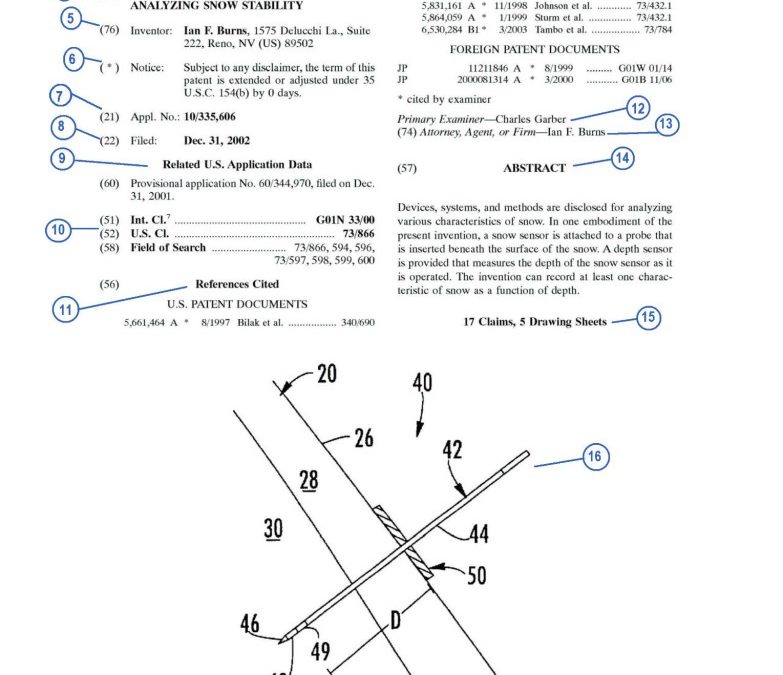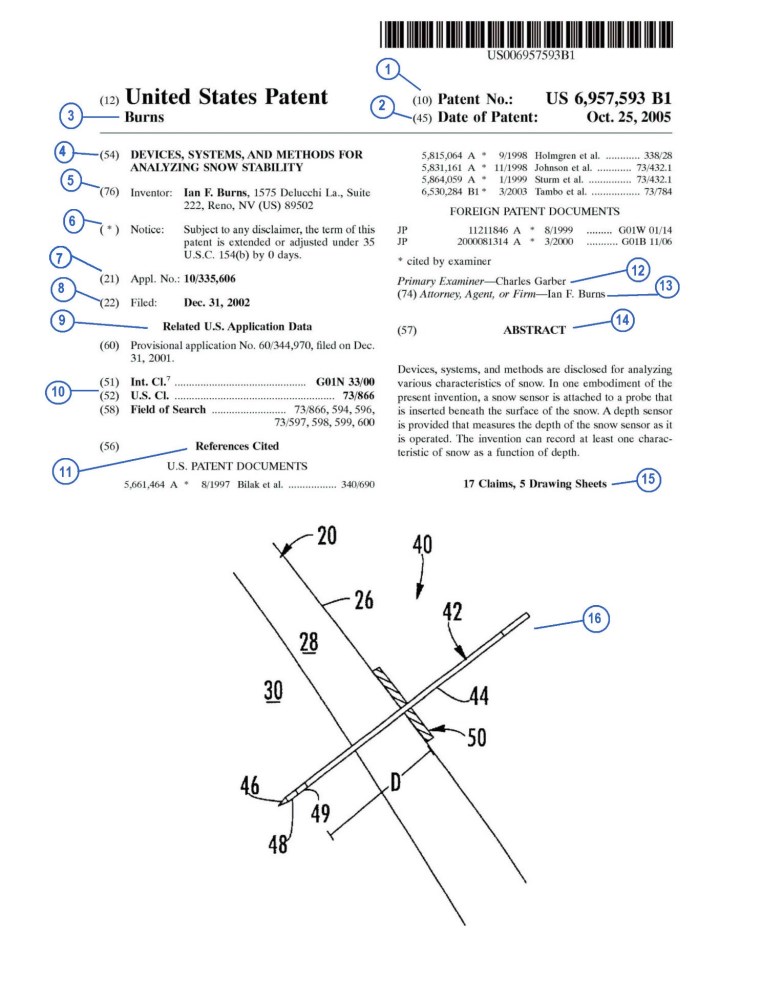Entrepreneurs, executives, engineers, venture capital investors and others are often faced with important decisions related to patents:
- file a patent application for a new invention
- commercialize or use a product that may infringe another party’s patent
- invest in a business that has a patent
- enforce a patent against an infringer
- defend against a patent infringement suit
- sell, purchase or license a patent
Although these issues involve analysis that should be performed by a patent attorney, a basic understanding of patents can help non-patent attorneys avoid problems, make better decisions, and communicate more effectively with their patent counsel. To understand a patent, it is essential to be able to read a patent.
How to Read Patents: Front Page
Front pages of patents are packed with useful information. But if you do not know how to read a patent, the front page can also be very confusing. This is what you need to know to get started:
Patent Number (1)
Each patent is assigned a unique sequentially generated number that is used to identify the patent (see “(1)” on the example patent). Patent attorneys often refer to a patent by the last three digits of the patent number. For instance, the example patent might be referred to as “the ‘593 patent.”
Inventor(s) (3) and (5)
Each patent has at least one inventor who is a person not a company. The last name of the first listed inventor is indicated at (3). Patent attorneys also refer to patents by the inventor name listed at (3). The example patent might be referred to as “the Burns patent.” All of the inventors in a patent are listed at (5) along with their city, state (if applicable), and country of residence.
In the case of multiple inventors, each inventor is free to commercialize the invention and license the patent without the approval of the other inventors, unless the inventor has executed an agreement to the contrary. If an applicant does not accurately provide all of the actual inventors, and the applicant does so with deceptive intent, the patent may be found to be invalid and unenforceable. It is also possible for an inventor who has been left off of a patent to sue and be added to the patent after the patent has issued.
Title (4)
The title indicates the subject matter of the patent. Although they are usually descriptive, titles of patents are sometimes misleading. For example, a title may be “AUTOMOBILE” and you may scratch your head and wonder how a patent could cover something as old and as broad as an automobile. But in fact the patent covers a much narrower concept, such as a self-driving car. Therefore, don’t judge a patent based only on the title.
Assignee
The assignment section (not shown on the example patent) is important because it provides an indication that someone other than the inventor(s) holds rights in the patent. Rights to a patent will often be assigned (transferred) by the inventors to another person or entity before the patent issues. Most employers require their employees to assign any inventions they make within the scope of their employment to the employer. However, assignee data on the face of the patent may be inaccurate for a number of reasons. Therefore, if ownership is an issue, it is important to perform an assignment search to help determine the status of ownership rights in the patent.
Application Number (7)
When a patent application is filed with the Patent Office, the application is assigned a unique application number (7), which is sometimes called the application serial number. This number is used to identify the application while it is pending in the Patent Office. The application number is sometimes useful in searching for related patents and pending applications and for looking up the file history of the patent.
Filing Date (8)
The filing date (8) is one of the most important pieces of information on a patent. Either the filing date or the issue date of the patent will determine how long the patent will be enforceable. There are a number of rules that determine the term of a patent. Utility patents are the most common type of patent sought by inventors. New utility patents have a term of 20 years from filing. However, this period can be adjusted. If any adjustments to the patent term have been made, they will be indicated on the face of the patent (6).
The filing date of a patent may also be used to determine what references can be used in determining the patentability of the invention and, in some circumstances, it determines the date the patent is effective as a reference against other applications.
Related U.S. Application Data (9)
The related application data (9) lists other applications that are related to the patent. Sometimes an applicant may file a number of different applications for an invention. If certain conditions are met, the applicant may be able to use the filing date of the earlier application as the “priority date” in an application filed later. This earlier “priority date” may influence what prior art references can be used to determine the patentability of the invention.
International Classification, U.S. Classification and Field of Search (10)
The International Classification, U.S. Classification, and Field of Search (10) are used to group the patent with similar technologies. The field of search indicates the classifications in which the patent examiner searched to locate prior art. This information can be helpful when performing a patent search for related inventions.
References Cited (11)
The References Cited (11) section lists selected patents and/or other publications that are in the application’s file. U.S. patent law requires applicants and their attorneys to submit all material prior art of which they are aware. If material prior art is intentionally not disclosed to the Patent Office, the patent can be invalidated in litigation.
Primary Examiner (12)
Each patent application is examined by at least one patent examiner. The examiner is responsible for determining the patentability of the invention and approving the application for patenting. In some cases, the name of an assistant examiner may also be listed.
Attorney, Agent or Firm (13)
This section lists the patent attorney, patent agent, or law firm that represented the applicant in the Patent Office during the prosecution of the application. Only a patent attorney, a patent agent or the actual inventor(s) can prosecute a patent application in the Patent Office.
Abstract (14)
The abstract (14) typically gives a brief overview of the invention. The abstract is used by patent searchers and examiners as a starting point when determining whether a prior patent is relevant to an application being considered. Just as the title can be misleading, so can the abstract. Do not rely solely on the abstract to determine the scope of a patent.
Claims and Drawings (15)
Section (15) indicates the number of claims and pages of drawings in the patent. As will be discussed further, while the number of claims may not be important, the claims substantially determine the patentee’s rights.
Front Page Drawing (16)
Most patents have at least one drawing. Applicants typically include a variety of views of their invention to aid in understanding the invention. If drawings are included in the patent, one (16) is typically included on the first page of the patent. The drawings can be a very useful starting place to understanding an invention. In the ‘593 patent, five pages of drawings are included. The drawings have numbers that are used to refer to particular features of the invention. The features of the invention are discussed in later sections of the patent, typically using the numbers on the drawings.
To Be Continued
In Part II of How to Read Patents, we will look at drawings, specification and claims.


